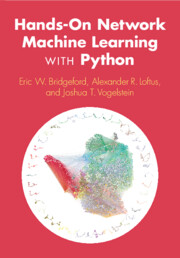Appendix B - Learning Representations Theory
Published online by Cambridge University Press: 23 September 2025
Summary
This appendix delves into the mathematical foundations of network representation techniques, focusing on two key areas: maximum likelihood estimation (MLE) and spectral embedding theory. It begins by exploring MLE for Erdös-Rényi (ER) and stochastic block model (SBM) networks, demonstrating the unbiasedness and consistency of estimators. The limitations of MLE for more complex models are discussed, leading to the introduction of spectral methods. The chapter then presents theoretical considerations for spectral embeddings, including the adjacency spectral embedding (ASE) and its statistical properties. It explores the concepts of consistency and asymptotic normality in the context of random dot product graphs (RDPGs). Finally, we extend these insights to multiple network models, covering graph matching for correlated networks and joint spectral embeddings like the omnibus embedding and multiple adjacency spectral embedding (MASE).
Keywords
Information
- Type
- Chapter
- Information
- Hands-On Network Machine Learning with Python , pp. 433 - 453Publisher: Cambridge University PressPrint publication year: 2025
Accessibility standard: WCAG 2.1 A
Why this information is here
This section outlines the accessibility features of this content - including support for screen readers, full keyboard navigation and high-contrast display options. This may not be relevant for you.Accessibility Information
Content Navigation
Allows you to navigate directly to chapters, sections, or non‐text items through a linked table of contents, reducing the need for extensive scrolling.
Provides an interactive index, letting you go straight to where a term or subject appears in the text without manual searching.
Reading Order & Textual Equivalents
You will encounter all content (including footnotes, captions, etc.) in a clear, sequential flow, making it easier to follow with assistive tools like screen readers.
You get concise descriptions (for images, charts, or media clips), ensuring you do not miss crucial information when visual or audio elements are not accessible.
